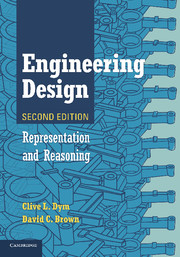Book contents
- Frontmatter
- Contents
- Preface
- Preface to the First Edition
- Acknowledgments
- 1 Framing the Issues
- 2 Engineering Design
- 3 Characterizing the Design Process
- 4 Taxonomies of Engineering Design
- 5 Representing Designed Artifacts
- 6 Representing Design Processes
- 7 Where Do We Go from Here?
- References Listed in First Edition
- New References
- Index
2 - Engineering Design
Published online by Cambridge University Press: 05 June 2012
- Frontmatter
- Contents
- Preface
- Preface to the First Edition
- Acknowledgments
- 1 Framing the Issues
- 2 Engineering Design
- 3 Characterizing the Design Process
- 4 Taxonomies of Engineering Design
- 5 Representing Designed Artifacts
- 6 Representing Design Processes
- 7 Where Do We Go from Here?
- References Listed in First Edition
- New References
- Index
Summary
Design is a ubiquitous word: We see it often and in many different contexts. For example, just in perusing our daily newspapers, we read about people who are automobile designers, dress designers, architectural designers, sound-system designers, aircraft designers, organization designers, highway designers, system designers, and so on and so forth. In fact, design has been a characteristic of human endeavor for as long as we can “remember” or, archaeologically speaking, uncover. Design was done in very primitive societies for purposes as diverse as making basic implements (e.g., flint knives) to making their shelters more habitable (e.g., the wall paintings found in primitive caves). However, because people have been designing artifacts for so long and in so many different circumstances, is it fair to assume that we know what design is, and what designers do and how they do it?
From Design to Engineering Design
Well, we do know some of the story, but we do not yet know it all. And, of course, one of the themes of this book is that we are still struggling to find ways of externalizing and articulating even that which we do know about design. For example, with regard to the design of elementary artifacts, it is almost certainly true that the “designing” was inextricably linked with the “making” of these primitive implements – that there was no separate, discernible modeling process. However, we can never know for sure, because who is to say that small flint knives, for example, were not consciously used as models for larger, more elaborate cutting instruments? Certainly people must have thought about what they were making because they recognized shortcomings or failures of devices already in use and evolved more sophisticated versions of particular artifacts. Even the simple enlargement of a small flint knife to a larger version could have been driven by the inadequacy of the smaller knife for cutting into the hides and innards of larger animals.♦ But we really have no idea of how these early designers thought about their work, what kinds of languages or images they used to process their thoughts about design, or what mental models they may have used to assess function or judge form.
- Type
- Chapter
- Information
- Engineering DesignRepresentation and Reasoning, pp. 12 - 19Publisher: Cambridge University PressPrint publication year: 2012
- 1
- Cited by



